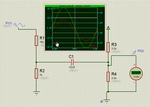ALERTLINKS
Advanced Member level 4
I repeat, the only difference between AC and DC is that the AC swings from minus voltage to positive voltage, if you have a sinusoidal of 5v peak to peak then the swing is from -2.5v to +2.5v, if you add a DC offset of 2.5v then the swing becomes -2.5v+2.5v to +2.5v+2.5v where +2.5v is the offset.
in the schematic of my previous post feed the AC input to V2, V1 to GND and Vr to +2.5v.
If you don't want gain then set all resistors to 1K
A typo should be written as, if you add a DC offset of 2.5v then the swing becomes from 0 to +5v.
